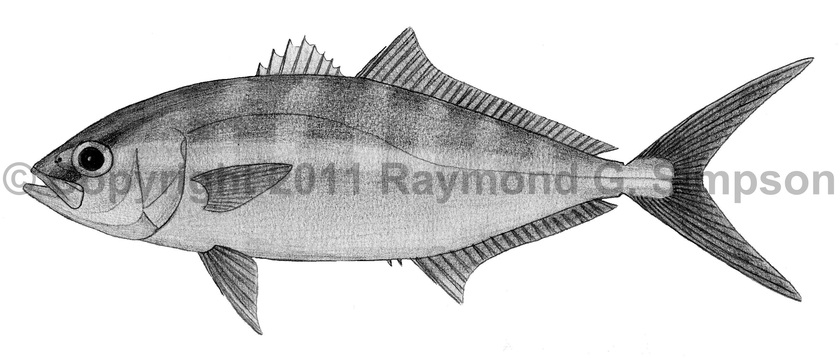
Common Name
Lesser Amberjack
Year Described
Bloch, 1793
Identification
Dorsal Fin: 8 spines (first and last may be embedded in larger fish), followed by I, 28-33
Anal Fin: 2 spines, followed by I, 19-22
Pelvic Fin: I, 5
Gill Rakers: 6-8 upper, 16-18 lower; 23-26 total
Vertebrae: 10 precaudal, 14 caudal
Elongate and moderately deep bodied. Jaw extends to the anterior margin of eye. Supramaxilla moderate. Teeth minute and present in both jaws. Spiny first dorsal much lower than second dorsal. Second dorsal base 1.6-1.9 times longer than anal fin base. Second dorsal and anal fin have raised anterior lobes with dorsal lobe contained 6.5-8.6 times in FL. Pelvic fins larger than pectoral fin. Lateral line with a shallow anterior arch and a straight posterior portion with no scutes. Caudal peduncle grooves present. Body smooth with tiny cycloid scales. First anal pterygiophore curved in fish >10cm.
Color
Adults pinkish to voilet dorsally, grading to silvery or white below. Faint eye stripe or golgen lateral band often present. Dorsal, anal, and caudal fins dusky, with white lobes on the dorsal/anal lobes and a white margin on the caudal fin. Pelvic fins white with dorsal surface dark. Pectoral fins pale to dusky. Juveniles pale with 7 irregular dark bars on body and a dark eye stripe, the body bars extending onto fins. An eighth band on caudal peduncle and a median black blotch on the caudal fin.
Size
Common to 50cm. Maximum size to 67cm.
Habitat
Epipelagic to demersal, from 55-130m. Juveniles often at the surface in pelagic waters.
Range
Massachusetts to the Gulf of Mexico, including Bermuda. Scattered records in the Caribbean Sea.
References
Smith-Vaniz, W.F. 2003. Carangidae (pp 1426-1468). In: Carpenter. 2003. The living marine resources of the Western Central Atlantic v. 3.